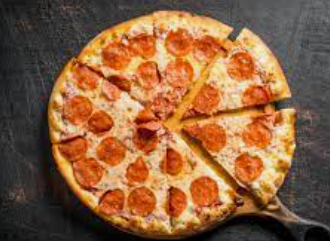How Many Calories in a Slice of Pizza: A Detailed Breakdown

Pizza, a beloved and universally popular dish, is a go-to choice for many. However, if you’re watching your calorie intake, you might be wondering, “how many calories in a slice of pizza?” In this article, we will provide you with an in-depth analysis of pizza’s caloric content, helping you make informed decisions about your diet. Read more
How many calories in a slice of pizza
Here the question is arise about how many calories in a slice of pizza. The calorie content of a slice of pizza can vary significantly based on various factors, including the type of pizza, its size, and the toppings. On average, a typical slice of plain cheese pizza, which is approximately 14 inches in diameter, contains around 285 to 300 calories. This provides a starting point for your calorie count, but it’s crucial to remember that many other factors can influence the calorie count.
Pizza Type
Thin crust: Thin-crust pizzas generally have fewer calories per slice compared to thick or stuffed crust pizzas. A slice of thin-crust cheese pizza may contain approximately 200 to 250 calories.
Thick crust: Deep-dish or thick-crust pizzas are more calorie-dense, with a slice averaging around 350 to 400 calories. Read more
Toppings
Meat toppings: Adding meat like pepperoni, sausage, or bacon significantly increases the calorie count. Each slice may have an extra 30 to 50 calories per meat topping.
Vegetables: Toppings like bell peppers, mushrooms, and onions are relatively low in calories, adding only 5 to 10 calories per slice.
Extra cheese: Extra cheese means extra calories, with each ounce of cheese adding approximately 110 calories to a slice.
Size
A larger pizza slice contains more calories than a smaller one. Consider the size of the slice when estimating your calorie intake. Read more
Specialty Pizzas
Specialty pizzas, like Hawaiian or BBQ chicken, can have varying calorie counts depending on their ingredients. These can range from 300 to 450 calories or more per slice.
Pizzeria Variations
It’s essential to consider that different pizzerias may use different recipes and ingredient quantities, leading to variations in calorie content. Always check with the establishment or refer to their nutritional information if available. Read more
Making Informed Choices
To make more informed choices about your pizza consumption, consider the following tips:
Opt for thin-crust and vegetable toppings to reduce calorie intake.
Practice portion control. Having just one or two slices is a healthier choice than indulging in several.
Share a pizza with friends to control portion sizes and share the calories.
Choose pizzerias that provide nutritional information, allowing you to track your calorie intake accurately.
Certainly, here are some frequently asked the questions (FAQs) related to the topic “How Many Calories in a Slice of Pizza,” along with informative answers:
FAQs
Q1: What is the average calorie count for a slice of pepperoni pizza?
A1: The calorie count for a slice of pepperoni pizza can vary depending on the pizzeria and the size of the slice. On average, a standard-sized slice of pepperoni pizza contains around 300 to 350 calories. The calorie count may increase with larger slices or if there is extra cheese or thicker crust.
Q2: Are there any low-calorie pizza options available?
A2: Yes, there are lower-calorie pizza options. Opting for a thin-crust pizza with vegetable toppings, such as peppers, mushrooms, and onions, can help reduce the calorie content. Some pizzerias also offer cauliflower crust or gluten-free crust pizzas, which may have fewer calories compared to traditional crusts.
Q3: How can I estimate the calorie count of a slice of pizza if I don’t have nutritional information available?
A3: Estimating the calorie count of a slice of pizza without nutritional information can be challenging. To get a rough estimate, you can refer to standard calorie counts for common pizza components, like cheese, meat, and crust. Keep in mind that this method may not provide precise numbers but can help you make an educated guess.
Q4: What’s the impact of extra cheese on the calorie count of pizza?
A4: Adding extra cheese to your pizza significantly increases its calorie count. An additional ounce of cheese can add around 110 calories to each slice. If you’re looking to reduce calories, consider opting for less cheese or choosing lower-fat cheese options.
Q5: Can I include pizza in my weight loss plan?
A5: Including pizza in your weight loss plan is possible, but it requires mindful choices. Opt for healthier variations like thin-crust, vegetable toppings, and portion control. Also, consider balancing your pizza consumption with other nutritious foods and regular physical activity.
Q6: Are there any healthy alternatives to traditional pizza?
A6: Yes, there are healthier alternatives to traditional pizza. You can make your own pizza at home with whole wheat crust, lean protein, and an abundance of vegetables. This way, you can control the ingredients and reduce the calorie content while enjoying a pizza-like experience.
Q7: Do different types of cheese affect the calorie count of pizza?
A7: Yes, different types of cheese can affect the calorie count. Mozzarella is commonly used on pizza and has around 85-90 calories per ounce, while cheddar and other high-fat cheeses can have more calories. Opt for lighter cheese options if you want to reduce calories.
Conclusion
Pizza can be enjoyed as a part of a balanced diet, but it’s essential to be aware of the calorie content in each slice, especially if you’re watching your calorie intake. The number of calories in a slice of pizza varies depending on several factors, such as the type of pizza, size, and toppings. By making informed choices and practicing moderation, you can savor your favorite pizza without worrying too much about your calorie count. Remember that balance is a key when it comes to enjoying this delicious treat. Read more



